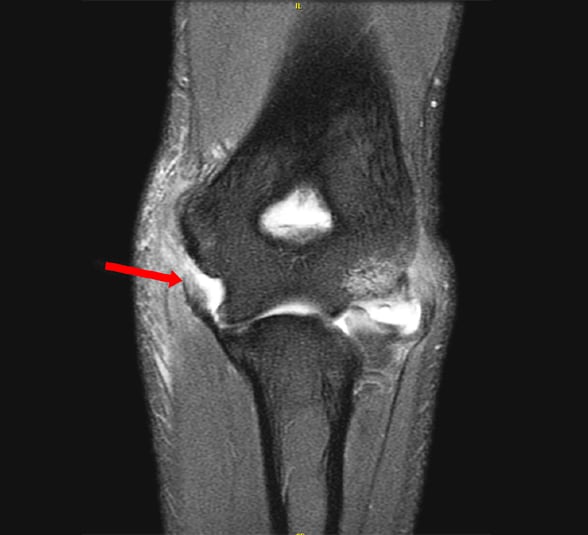Sept. 18, 2018
UCL injury

UCL injury
MRI shows a complete ulnar collateral ligament (UCL) tear (arrow).
Mayo Clinic works with baseball players of all levels, from youth leagues to Major League Baseball, to enhance prevention and treatment of ulnar collateral ligament (UCL) injuries, also known as Tommy John injuries. UCL reconstruction is one of the most common surgeries performed in overhead-throwing athletes, and the incidence of these injuries is rising.
"We're mobilizing all of our multidisciplinary resources to attack this problem," says Christopher L. Camp, M.D., an orthopedic surgeon at Mayo Clinic in Rochester, Minnesota. "Once we get a handle on the risk factors, we need to work to reverse the dramatic climb in incidence. We are also working hard to redesign the surgical techniques and find ways to optimize the healing environment to speed up recovery."
A number of studies have shown significant increases in UCL injuries at all levels. "The most rapid rise in injury rates is actually occurring among players ages 15 to 19," Dr. Camp notes. "That's most likely due to overuse from year-round play. These kids sometimes pitch daily, and even on days when they're not pitching, they're playing different positions in the field. The arm's not getting a break."
Although college and professional teams monitor players' workloads, pitchers at those levels are throwing harder. "The ligament in isolation can only tolerate a load of 32 to 36 newton meters (N m). In high-end athletes, the throwing motion generates up to 90 N m of torque," Dr. Camp says. "Bony constraints and muscles take up some of that force, but up to 50 N m is going to the ligament itself with every maximal-effort throw."
Mayo Clinic's approach
Surgical reconstruction is the gold standard of care for UCL injuries. But depending on factors such as the patient's age and extent of injury, Mayo Clinic might consider other approaches.Nonsurgical options such as guided physical therapy might be recommended for patients with incomplete tears, patients who don't plan to continue competitive play or for adolescent patients, to avoid surgery during skeletal growth. Mayo Clinic also is researching therapies involving injections of platelet-rich plasma or stem cells, to determine which patients might benefit from those nonsurgical treatments.
UCL surgical repair historically has been considered less successful than reconstruction. But stronger sutures and new anchoring techniques have improved outcomes for UCL repair, particularly for proximal avulsion injuries. Surgical repair can be an option for high school and college athletes who may not have the option of undergoing the prolonged post-reconstruction rehabilitation — which lasts an average of 12 to 18 months.
"That long recovery period can be pretty devastating," Dr. Camp says. "A high school pitcher who isn't going to play college baseball has only four seasons. He might lose one or two of them if he has to have UCL reconstruction surgery."
Mayo Clinic's team approach ensures that orthopedic surgeons, athletic trainers, physiatrists and radiologists work together to determine the optimal treatment for individual patients.
"We're aiming to get people on the right treatment pathway at the time of diagnosis," Dr. Camp says. "If you try a nonsurgical approach for an extended period of time and the patient ultimately has to have surgery, the patient can easily miss two years of play."
To help prevent UCL injuries, researchers in Mayo Clinic's Motion Analysis and Orthopedic Biomechanics laboratories are working to identify risk factors — including determining the maximal workloads and optimal throwing mechanics for younger players. Other research focuses on improving reconstructive surgery.
"We are designing a novel reconstruction technique using new types of anchors and sutures, with a goal of maximizing healing potential, maintaining the strength of the construct and reducing the time required to return to play. Preliminary biomechanical analysis is showing very promising results so far," Dr. Camp says.
An additional effort to quicken return to play involves individualized post-reconstruction rehabilitation. "Historically, we have had a set program that slowly increases the number and velocity of the patient's throws over a defined period of time. If the patient starts having trouble, we often have to scale back the program," Dr. Camp says. "We're now looking at ways to quickly and easily measure the actual workload for each player going through the rehab process. Players who have poor mechanics or increased torque on their elbows might have to slow down a bit, whereas those with better mechanics and less torque can probably progress a little more quickly.
"Mayo's strength in this area of UCL injuries is that we can take a comprehensive approach," he adds. "Our patient population and the experience of our surgeons, researchers, therapists, trainers and many more will help us make significant progress in the prevention of these injuries and optimization of surgery treatments when they're needed."